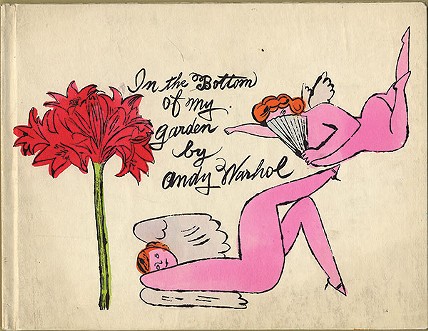One of the last truly notable works connected to Andy Warhol was a book: the edited, posthumously released diaries covering just over a decade of his life, beginning in 1976 and concluding just five days before his death, in 1987. It was an appropriate denouement, as many of Warhol’s earliest illustrations were seen on the covers and insides of books.
Warhol by the Book, curated by the Warhol’s chief archivist, Matt Wrbican, documents Warhol’s connection to the printed volume from the beginning of his career to the end of his life. The majority of the works by Warhol are from the 1940s and 1950s. It’s a body of creative drawing in a style that was simple, whimsical, frequently childlike and disingenuous. Often, it gave seemingly no indication of the work that was to come, and by which Warhol would become not only known but defined.

The illustrations of fat pink cherubs, naked and saucy, squatting amid flower petals, and cats, shoes, more cats, poodles and still more cats, are all rendered in simple black ink and washes of solid color. There are several covers of what appear to be mystery books (not by particularly well-known authors); tons of children’s volumes decorated inside and out; and books of languages and cooking for which the eventual tycoon of pop art served as artist for hire. (One of Warhol’s contributions is labeled “Cuts of Pork.”)
A few tomes were designed and crafted by Warhol along with family members or artistic collaborators, produced in tiny quantities as labors of love. Pistols emblazoning murder mysteries offer a bit of biographical foreshadowing. More fun are Warhol’s treatment of the well-known “The Little Red Hen” and the more obscure “Sophocles the Hyena,” both charming and delightful.
Traveling through the exhibition, one does the same through time, and in the 1960s Warhol’s artistic efforts become autonomous and take a different, and recognizable direction. This later work focused not on books, but on celebrities like James Dean and Marilyn Monroe, with the signature Warhol treatment: silkscreened images in duplicate, identical in the black lines separating space, disparate in the color that fills them. The literary world wasn’t far away, with the same treatment extended to Gertrude Stein, Johann Wolfgang von Goethe and Hans Christian Andersen. And this is where we see how one thing led to another — the same elementary lines, the same saturation of color visible on those early fat cherubs continues. The techniques and media have changed, the footstep is different, but the path the same.














